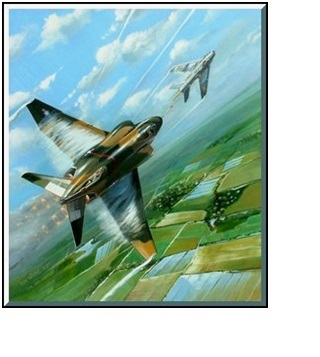Author has obtained the entire remaining Artist’s Proof Lithographs from Rich Thistle, the renowned Canadian artist that painted Rhino Charge.…
- Each is numbered and signed by both the artist and author.
- Measuring 22.5” tall x 19.25” wide, they were sold on the artist’s web site for $160 (Canadian) each.
- It accurately captures the end game parameters of the only supersonic gun kill in the history of aerial combat; 500 feet above ground, 90 degree crossing angle; slant range to target 200-300 feet.
Available on Amazon
Author's Comment
"Precise in every detail, this painting captures with total accuracy the last 0.15 seconds of a 102 second engagement that began at 15,000 feet and terminated 500 feet above the ground approximately 40 miles northeast of Hanoi on 2 June 1972. The History Channel video entitled “Supersonic” was excellent up to the final moments, but totally botched the end game kill by making the cannon shot look like a low-angle tracking shot from a machine gun vs. the actual speed and geometry."

Artist's Comment
Rhino Charge F-4 Phantom Viet Nam War A Pilot's Story
Commissioned by Col. Phil Handley 3 DFC's, Silver Star USAF (Ret.), who has been featured twice in the History Channel TV Series DOG FIGHTS, RHINO CHARGE may well be the definitive Phantom II ("McDonnell Rhinoceros") combat painting. Created with intense attention to every detail through the ongoing involvement of Col. Handley, the USAF F-4 pilot who made history in the skies over Hanoi, this painting dramatically depicts a unique moment in the history of aerial combat. On June 2, 1972, at approximately 1330 hours, while in a flight of four F-4Es on CAP (combat air patrol) flying Brenda 01, a hard-wing F-4E, tail number 68210, at over 1.2 mach, Maj. Phil "Hands" Handley shot down a MiG-19 with 20 mm cannon fire 40 miles northeast of Hanoi. The estimated flight parameters were; F-4 speed over 1.2 mach (800 kts); MiG 19 speed mach 0.77 (500 kts); altitude above terrain 500 feet; slant range 200-300 feet; and flight path crossing angle 90 degrees. It was one of the first victories for an F-4 with internal cannon, the only MiG-19 shot down by cannon fire during the course of the war in Southeast Asia, and believed to be the highest speed deflection-shot gun kill in the entire history of aerial combat. Here is a quote from an email message I received from Phil as the painting progressed ... "Can you imagine Rich what an air show this would have been to a North Vietnamese worker in one of the rice paddies directly below this scene? Jaded by the years of seeing numerous flights of MiGs and American fighters overhead and hearing the distant rumble of heavy bombing, he had learned to mostly ignore the continuing saga which he wished would go away. However, just over a minute and one-half earlier an echoing muffled boom had attracted his attention. Brenda 01 accelerated through the mach several miles southwest of him. Focusing upon the rapidly turning and descending F-4, his eyes also picked up a second F-4 which was climbing upward and turning slowly left. Soon he saw two more silver aircraft descending and turning to the north. Continuing to watch, he saw a streak come from the F-4 in the direction of the silver aircraft, but it seemed to simply fly harmlessly upward. As his gaze passed northwest, he could not believe how fast all three of the airplanes seemed to be going. Just then a second streak left the brown airplane and flew behind the silver planes. He now realized that all of the airplanes were going faster than he had ever seen, and that they were very, very low. As he now faced directly north, he looked to the northeast to see the rapidly approaching silver aircraft, and back to the north to see the brown airplane. He suddenly realized that all of them were going to converge directly over his head. He snapped his head to the right as his ears sensed the high-pitch squeal of the four after burning engines of the MiGs and noted that there was some sort of fog streaming off both of the rapidly turning silver airplanes. Quickly checking back to the north, he saw the same fog streaming from the big brown airplane, but, oddly could hear no noise from its direction. Just then, a long streak of red fire shot from the nose of the brown airplane and his ears heard the staccato cracks of one hundred 20 mm rounds per second breaking the sound barrier over his head at over mach 4.5. Now, in less than one second both of the silver airplanes screamed directly over him in a westerly direction amidst the loudest roar he had ever heard. At the same instant, he thought he saw some sort of sparkles and puffs on the second silver airplane... but had no time to reflect upon it, for as the brown airplane passed directly over his head, the air in his lungs was suddenly expelled as if hit with a bat when the mach-Y stem of the F-4's shock wave swept over him. Now crouching on the ground and looking directly south, his eyes followed the brown airplane which had snapped out of its right turn and was pulling rapidly into a vertical climb. As he looked back to his right he saw the second of the silver airplanes streaming fire, with its wings rocking and nose dropping. He continued to watch and in less than ten seconds it hit the ground in one of the neighboring rice paddies, exploding into a huge orange ball of fire. He dropped his rake and began to run toward the black smoke....